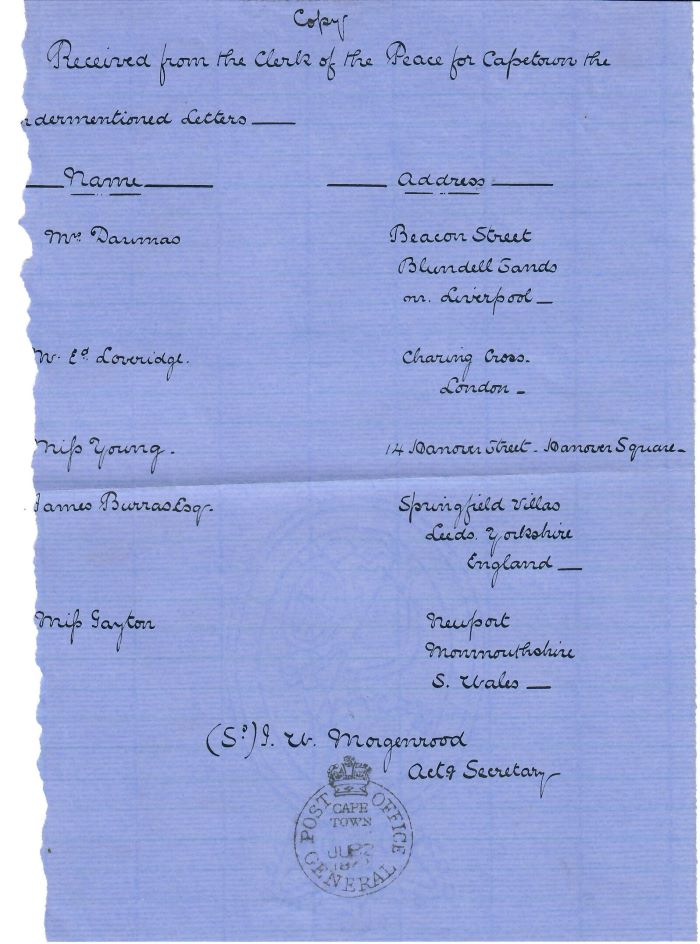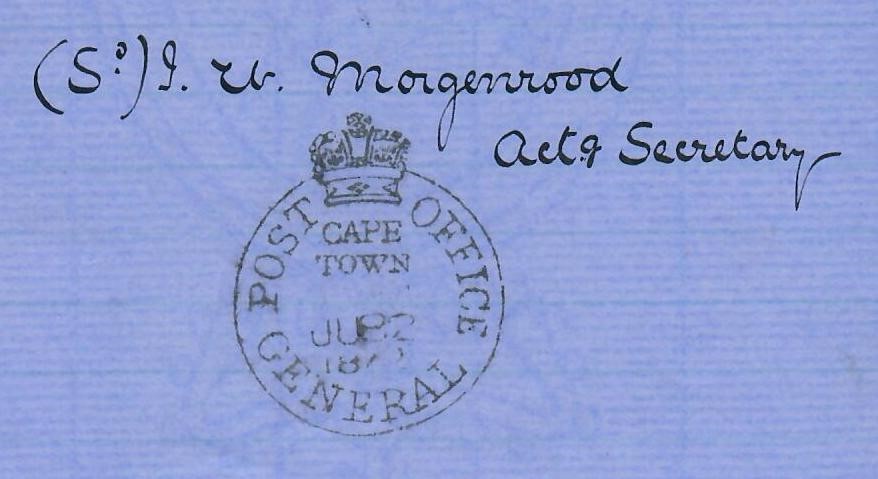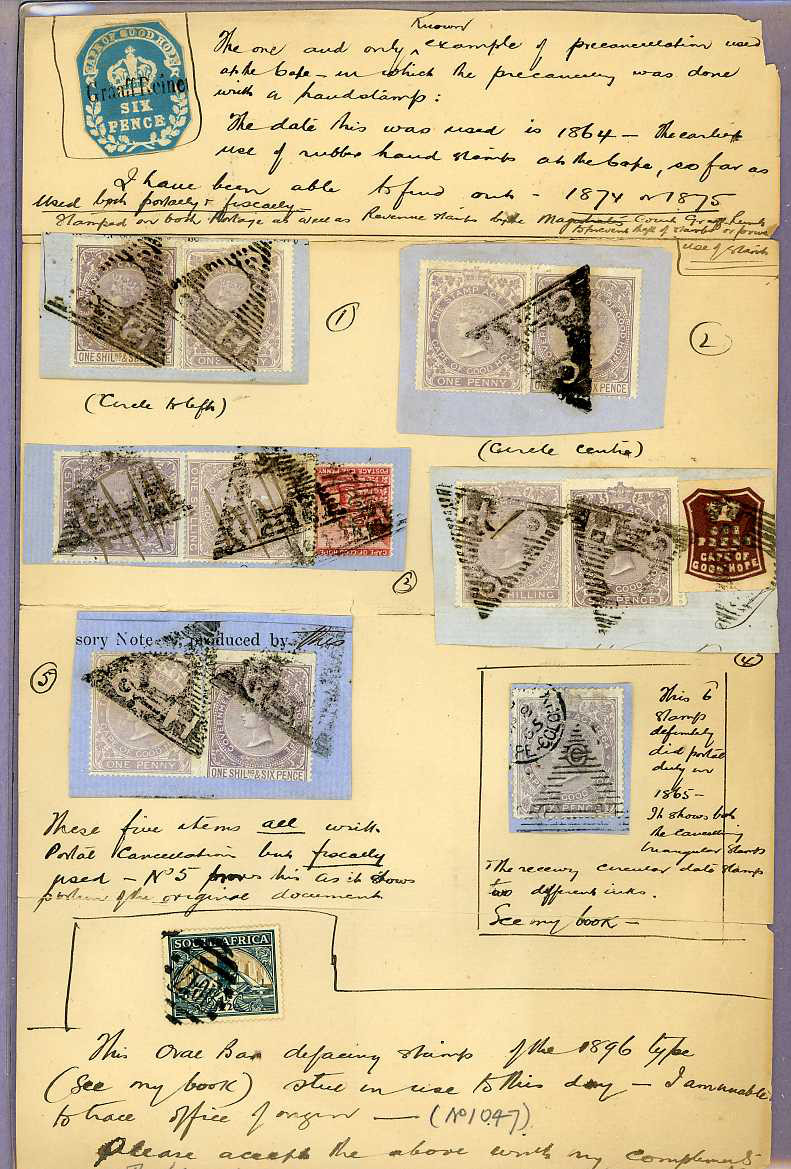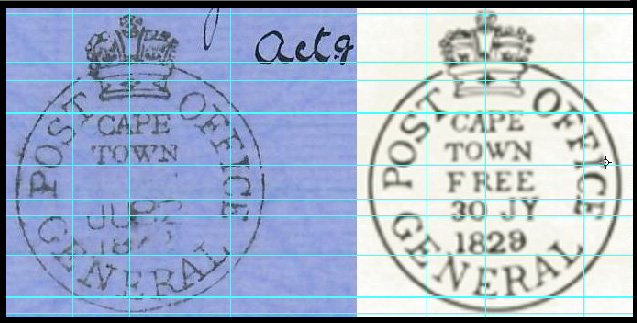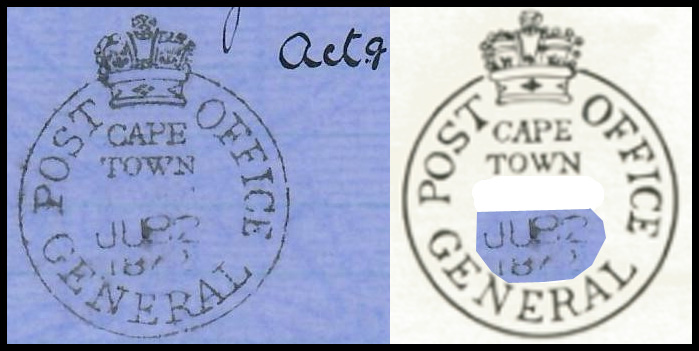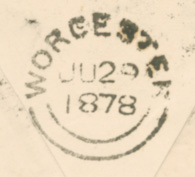Cape of Good Hope - Unrecorded Official Letter Stamp
Quote from yannisl on May 14, 2020, 10:43 pmI have an item, shown in the images below bearing a handstamp that appears to be unrecorded to my knowledge. The handstamp is almost a faithful reproduction of the Official Letter Stamp 02 of 1828, in every way except that the lettering for "Cape Town" at top is minutely larger and more rounded, the date at bottom is now "sans serif" and in the centre the word "Free" removed. This handstamp was probably a new letter stamp manufactured by D.G. Berri of London or the original one of 1828 with the inner part modified. The letter is a receipt for five registered items which were handed in at the GPO Cape Town for delivery. It is signed by J.W. Morgenrood, Acting Secretary.
Has anyone seen this before or can provide more information?
I have an item, shown in the images below bearing a handstamp that appears to be unrecorded to my knowledge. The handstamp is almost a faithful reproduction of the Official Letter Stamp 02 of 1828, in every way except that the lettering for "Cape Town" at top is minutely larger and more rounded, the date at bottom is now "sans serif" and in the centre the word "Free" removed. This handstamp was probably a new letter stamp manufactured by D.G. Berri of London or the original one of 1828 with the inner part modified. The letter is a receipt for five registered items which were handed in at the GPO Cape Town for delivery. It is signed by J.W. Morgenrood, Acting Secretary.
Has anyone seen this before or can provide more information?
Uploaded files:Quote from Steve on May 15, 2020, 1:06 pmYannisl, this is a fascinating item, meat and drink to me as a Capey (not a Capetonian) and a COGH collector. I thought it so interesting and important that I contacted Alex Visser before putting finger to keypad. (When last did you actually put pen to paper?)
Alex has provided a fact-based, unemotional answer to my "Gee whiz, this is possibly a major discovery. It is not everyday that one finds a new datestamps, (okay, a variety of one), from that era, circa 1828". Alex has replied with more consideration. He says "It is difficult to compare small differences electronically. The item looks like Putzel 8 on p 31 of Postmarks book volume 2, or DLS 3 in Goldblatt p50. The spacing may vary as the slugs were placed into an opening which may not all be filled."
Okay, I have consulted both books and I reluctantly feel the need to disagree with Alex. The reasons why I was so excited by your postmark is because, first, it bears the words 'GENERAL POST OFFICE CAPE TOWN. Clearly, it was originally intended to be used as a post office datestamp. In looking at the reference books, it looks more like Putzel 10, page 31, Goldblatt O2, page 68, with FREE removed. Second, it has a sans serif date. This alone is enough to show that it is a variety of anything Putzel ot Goldblatt show.
What is the date? It looks like 'JU 82 18..'. Very Odd. The paper looks like it has the 'Brittania Seated' watermark, some of which, I believe, came to the Cape with and or after the 1806 Occupying Forces. It is not critical but it does suggest that this is a genuine document from the right time, the late 1820s. Large stocks of this watermarked were paper used by the British administration.
The Assistant Secretary (to the Cape PO) who has signed this is a Morgenrood. That family had a long history of employment in the Cape Post Office throughout the 19th c. This document has been signed by a Cape GPO official who was using a cobbled together (the sans serif date slugs with FREE removed) datestamp to date a postal service (sending a batch of letters to various parties in GB) on behalf of the Clerk of the Peace. If that is correct, this document shows proof of post office use of that datestamp. The Cape GPO would have wanted the word 'FREE' removed if this datestamp was used to date documents as proof that a service it offered had been paid for and or entered into.
In my opinion you have found an unlisted variety of one of SA's earliest datestamps. Congratulations!
The South African Philately Club is proud and pleased to be party to this major new discovery!
Anyone with objections to my conclusion is welcome to challenge my assumptions here.
Yannisl, this is a fascinating item, meat and drink to me as a Capey (not a Capetonian) and a COGH collector. I thought it so interesting and important that I contacted Alex Visser before putting finger to keypad. (When last did you actually put pen to paper?)
Alex has provided a fact-based, unemotional answer to my "Gee whiz, this is possibly a major discovery. It is not everyday that one finds a new datestamps, (okay, a variety of one), from that era, circa 1828". Alex has replied with more consideration. He says "It is difficult to compare small differences electronically. The item looks like Putzel 8 on p 31 of Postmarks book volume 2, or DLS 3 in Goldblatt p50. The spacing may vary as the slugs were placed into an opening which may not all be filled."
Okay, I have consulted both books and I reluctantly feel the need to disagree with Alex. The reasons why I was so excited by your postmark is because, first, it bears the words 'GENERAL POST OFFICE CAPE TOWN. Clearly, it was originally intended to be used as a post office datestamp. In looking at the reference books, it looks more like Putzel 10, page 31, Goldblatt O2, page 68, with FREE removed. Second, it has a sans serif date. This alone is enough to show that it is a variety of anything Putzel ot Goldblatt show.
What is the date? It looks like 'JU 82 18..'. Very Odd. The paper looks like it has the 'Brittania Seated' watermark, some of which, I believe, came to the Cape with and or after the 1806 Occupying Forces. It is not critical but it does suggest that this is a genuine document from the right time, the late 1820s. Large stocks of this watermarked were paper used by the British administration.
The Assistant Secretary (to the Cape PO) who has signed this is a Morgenrood. That family had a long history of employment in the Cape Post Office throughout the 19th c. This document has been signed by a Cape GPO official who was using a cobbled together (the sans serif date slugs with FREE removed) datestamp to date a postal service (sending a batch of letters to various parties in GB) on behalf of the Clerk of the Peace. If that is correct, this document shows proof of post office use of that datestamp. The Cape GPO would have wanted the word 'FREE' removed if this datestamp was used to date documents as proof that a service it offered had been paid for and or entered into.
In my opinion you have found an unlisted variety of one of SA's earliest datestamps. Congratulations!
The South African Philately Club is proud and pleased to be party to this major new discovery!
Anyone with objections to my conclusion is welcome to challenge my assumptions here.
Quote from yannisl on May 15, 2020, 5:04 pmSteve, thanks for taking the time to answer my post and also for contacting Alex Visser for his opinion. I agree with your conclusions that it is a new find. However as Alex suggested it is difficult to make comparisons from a scan. What I will do once I am back in the office I will measure and describe it more accurately.
My first thought when I discovered it, was to suspect a Jurgen's fabrication; but then everything pointed against it. If he did fabricate it, there were bound to be many more copies floating around, especially if he expected to profit from it in some way. I looked at a reference sheet I have, showing many of Jurgen's inventions and if he had manufactured it he would have been tempted to include it. The sheet appears to have been written in his own hand and was sent to Robson Lowe, but this is best left for another topic!
Steve, thanks for taking the time to answer my post and also for contacting Alex Visser for his opinion. I agree with your conclusions that it is a new find. However as Alex suggested it is difficult to make comparisons from a scan. What I will do once I am back in the office I will measure and describe it more accurately.
My first thought when I discovered it, was to suspect a Jurgen's fabrication; but then everything pointed against it. If he did fabricate it, there were bound to be many more copies floating around, especially if he expected to profit from it in some way. I looked at a reference sheet I have, showing many of Jurgen's inventions and if he had manufactured it he would have been tempted to include it. The sheet appears to have been written in his own hand and was sent to Robson Lowe, but this is best left for another topic!
Uploaded files:
Quote from Steve on May 16, 2020, 6:47 amJurgensiana crossed my mind as a possibility while I was lying in bed last night. But then sleep came and so here I am the next morning with you one step ahead of me. The sheet is fascinating. I have been collecting Jurgensiana on and off but have nothing like that. I agree, an article on A A Jurgens RDPSA, is needed. You say your sheet was sent by Jurgens to Robson Lowe, the man who claimed he was a forger. Such communication suggests familiarity between them. Was Jurgens trying to hoodwink Lowe? Did Lowe take exception and become antagonistic to Jurgens as a result? How did Lowe find proof that Jurgens was a forger? Why has no official body removed Jurgens from the philatelic pantheon? (Because societies take an age to arrange to meet, then have a conversation with no agreement at the end of it! Better to let sleeping dogs lie!) I will draft an article on Jurgens. I must now go for an early morning walk. I am the family dog.
Jurgensiana crossed my mind as a possibility while I was lying in bed last night. But then sleep came and so here I am the next morning with you one step ahead of me. The sheet is fascinating. I have been collecting Jurgensiana on and off but have nothing like that. I agree, an article on A A Jurgens RDPSA, is needed. You say your sheet was sent by Jurgens to Robson Lowe, the man who claimed he was a forger. Such communication suggests familiarity between them. Was Jurgens trying to hoodwink Lowe? Did Lowe take exception and become antagonistic to Jurgens as a result? How did Lowe find proof that Jurgens was a forger? Why has no official body removed Jurgens from the philatelic pantheon? (Because societies take an age to arrange to meet, then have a conversation with no agreement at the end of it! Better to let sleeping dogs lie!) I will draft an article on Jurgens. I must now go for an early morning walk. I am the family dog.
Quote from Steve on May 27, 2020, 12:25 pmI have decided to revisit this O2 postmark because I feel that I did not look carefully enough at it.
In the first image, I have aligned Jannisl's supplied GENERAL POST OFFICE CAPE TOWN image alongside the one shown in Robert Goldblatt's "Postmarks of the Cape of Good Hope" and described as 'O2', (page 68), introduced in 1824.
The guide lines I have drawn across these images show that there are only minor variations in the size and setting. In other words, they are fundamentally the same datestamp. Besides the thicker outside lines, the biggest and only real difference lies in the 'P' on the left. Jannisl's image shows his 'P' to be bigger and lower in position. What is important to note is that all the other letters of this postmark align with those in Goldblatt's example. Only the 'P' raises a question.
I believe that the difference in the shape and position of the two 'P's is an artist's error made copying the postmark. Those who have recreated postmarks using relatively sophisticated computer software will know how difficult it is to accurately reproduce a postmark, especially when what you are copying is incomplete to begin with. At this point, some dangerous guesswork comes into play. For this reason, postal historians, as Ralph Putzel learned and acknowledged, generally prefer to see the real thing rather than what the person reproducing the postmark imagined should be there.
So, I am of the opinion that Jannisl's postmark is likely to be a more accurate image of the O2 datestamp than Goldblatt's. Proof of this statement will lie in examining other examples of the O2 datestamp. Sadly, I do not currently have one in my possession. (I have a lot of others but not this one!) However, I have taken a quick skwizz at a leading Cape postal history site and its only example of this datestamp suggests that overall the 'P' in Jannisl's example is a closer but still not an identical match. Club members are requested to please scan and send me good examples of their O2 datestamps and attach it as a Reply to this thread. Thanks.
In the second image, I have taken Goldblatt's O2, deleted 'FREE' and inserted the date from Jannisl's example. It fits.
There are obvious questions about the date. Goldblatt shows the use of a serif font throughout the postmark. Jannisl's has a san serif date slug. It is an obvious and significant difference. It struck me that the san serif type used for the date matches that seen on the DTO (Dated Town Oval of 1853). The issue that leaps out is that few if any Cape datestamps used this typeface before the 1850s.
I attach an example of a Double Arc datestamp of 1857 which uses a typeface similar to Jannisl's example, and which is also the same as DTO typefaces. The use of this typeface suggests that Jannisl's adapted O2 postmark possibly came into use from the mid-1850s onwards. It would be interesting to know when the O2 was discontinued and if there was life after death for it in a capacity like this.
Jannisl's date appears to be 'JU 82' with no space between. Beneath this can be seen '18' with possibly the suggestion of 72. However, a date of 'JU 82 1872' makes no sense at all. Is the date not 'JU 82 18'? (18th June 82?) This format would be highly unusual, perhaps only acceptable in a cobbled-together ad hoc datestamp. Also, such late use of an 02 datestamp like this in 1882 would presumably come as a surprise to most postal historians. No, I think that what happened was that the postal clerk reversed the day slugs! It is arguable that a date of '28 JU 18xx' is the more likely. Perhaps the year is 1842. This is about as late a date as we can realistically imagine this O2 used.
The watermark in the document appears to be 'Brittania seated'. This suggest the paper was used earlier rather than later in the 19th century.
Critical to unravelling this mystery is knowing when J W Morgenrood worked in the CT GPO. It must be possible to uncover this.
Hazarding a guess based on the sharpness of this postmark, the datestamp had not seen much use or was very well-maintained. It may never have been used as an Official Free datestamp and being surplus to requirements and in good condition it was adapted for dating post office counter receipts. How it got to use a san serif typeface before 1850 is awkward! This supplied piece does not prove postal use as a dispatch or receiving datestamp but it does show post office counter use. As such, it is a bona fide postmark.
I have decided to revisit this O2 postmark because I feel that I did not look carefully enough at it.
In the first image, I have aligned Jannisl's supplied GENERAL POST OFFICE CAPE TOWN image alongside the one shown in Robert Goldblatt's "Postmarks of the Cape of Good Hope" and described as 'O2', (page 68), introduced in 1824.
The guide lines I have drawn across these images show that there are only minor variations in the size and setting. In other words, they are fundamentally the same datestamp. Besides the thicker outside lines, the biggest and only real difference lies in the 'P' on the left. Jannisl's image shows his 'P' to be bigger and lower in position. What is important to note is that all the other letters of this postmark align with those in Goldblatt's example. Only the 'P' raises a question.
I believe that the difference in the shape and position of the two 'P's is an artist's error made copying the postmark. Those who have recreated postmarks using relatively sophisticated computer software will know how difficult it is to accurately reproduce a postmark, especially when what you are copying is incomplete to begin with. At this point, some dangerous guesswork comes into play. For this reason, postal historians, as Ralph Putzel learned and acknowledged, generally prefer to see the real thing rather than what the person reproducing the postmark imagined should be there.
So, I am of the opinion that Jannisl's postmark is likely to be a more accurate image of the O2 datestamp than Goldblatt's. Proof of this statement will lie in examining other examples of the O2 datestamp. Sadly, I do not currently have one in my possession. (I have a lot of others but not this one!) However, I have taken a quick skwizz at a leading Cape postal history site and its only example of this datestamp suggests that overall the 'P' in Jannisl's example is a closer but still not an identical match. Club members are requested to please scan and send me good examples of their O2 datestamps and attach it as a Reply to this thread. Thanks.
In the second image, I have taken Goldblatt's O2, deleted 'FREE' and inserted the date from Jannisl's example. It fits.
There are obvious questions about the date. Goldblatt shows the use of a serif font throughout the postmark. Jannisl's has a san serif date slug. It is an obvious and significant difference. It struck me that the san serif type used for the date matches that seen on the DTO (Dated Town Oval of 1853). The issue that leaps out is that few if any Cape datestamps used this typeface before the 1850s.
I attach an example of a Double Arc datestamp of 1857 which uses a typeface similar to Jannisl's example, and which is also the same as DTO typefaces. The use of this typeface suggests that Jannisl's adapted O2 postmark possibly came into use from the mid-1850s onwards. It would be interesting to know when the O2 was discontinued and if there was life after death for it in a capacity like this.
Jannisl's date appears to be 'JU 82' with no space between. Beneath this can be seen '18' with possibly the suggestion of 72. However, a date of 'JU 82 1872' makes no sense at all. Is the date not 'JU 82 18'? (18th June 82?) This format would be highly unusual, perhaps only acceptable in a cobbled-together ad hoc datestamp. Also, such late use of an 02 datestamp like this in 1882 would presumably come as a surprise to most postal historians. No, I think that what happened was that the postal clerk reversed the day slugs! It is arguable that a date of '28 JU 18xx' is the more likely. Perhaps the year is 1842. This is about as late a date as we can realistically imagine this O2 used.
The watermark in the document appears to be 'Brittania seated'. This suggest the paper was used earlier rather than later in the 19th century.
Critical to unravelling this mystery is knowing when J W Morgenrood worked in the CT GPO. It must be possible to uncover this.
Hazarding a guess based on the sharpness of this postmark, the datestamp had not seen much use or was very well-maintained. It may never have been used as an Official Free datestamp and being surplus to requirements and in good condition it was adapted for dating post office counter receipts. How it got to use a san serif typeface before 1850 is awkward! This supplied piece does not prove postal use as a dispatch or receiving datestamp but it does show post office counter use. As such, it is a bona fide postmark.
Uploaded files:Quote from Bas PAYNE on May 30, 2020, 12:50 pmAs someone whose main area of interest is north of the Vaal, I comment with hesitation; but as no-one has yet posted a scan of another example of Goldblatt O2, I thought it might be worth scanning three relevant images from Putzel's catalogue - the date-stamp in question being his Put 9/9a. All have been blown up to approximately the same size.
A simple way to compare them in detail is to print them on OHT transparency film. The accompanying note in Putzel makes it clear that detail in his images has been emphasised for clarity, so some caution is needed; however the overall similarity is clear, especially in the spacing of the letters in "POST OFFICE / GENERAL". So far, so good; but the use of larger numbers without serifs appears to be problematic not only, as Steve comments, because these would have been unusual before the 1850s, but also because the numbers are larger, so there would have been problems fitting larger slugs into the smaller spaces in the date-stamp .....
As someone whose main area of interest is north of the Vaal, I comment with hesitation; but as no-one has yet posted a scan of another example of Goldblatt O2, I thought it might be worth scanning three relevant images from Putzel's catalogue - the date-stamp in question being his Put 9/9a. All have been blown up to approximately the same size.
A simple way to compare them in detail is to print them on OHT transparency film. The accompanying note in Putzel makes it clear that detail in his images has been emphasised for clarity, so some caution is needed; however the overall similarity is clear, especially in the spacing of the letters in "POST OFFICE / GENERAL". So far, so good; but the use of larger numbers without serifs appears to be problematic not only, as Steve comments, because these would have been unusual before the 1850s, but also because the numbers are larger, so there would have been problems fitting larger slugs into the smaller spaces in the date-stamp .....
Uploaded files:
Quote from yannisl on May 30, 2020, 5:51 pmSteve, thanks for expanding your comments. I will come back in a coupe of days and post a longer response, as I am trying to get info as to when J W Morgenrood worked in the Cape Town GPO. I agree with you this is critical info.
Bas, thanks for scanning the images and providing additional commentary. I would agree with you that the document must be at least post 1840s if not later and I wouldn't be surprised at all even if it was post 187os, as the Post Office in those days would only replace items if it was absolutely necessary. Cancellers were "worked" until they "died". You can see this in the use of BONCs and other cancellers well into the Union era. The most striking examples being the re-use of octagonal and triangular defacers.
I mainly collect Cape of Good Hope. Years back I wanted to expand into other South African areas but never really got into it in any serious way. I have a good section of "Pietersburg" material (no covers Tamsen or otherwise) which I still need to decipher one day and write it up. From a cancellation point of view I have covers of the T.P.O.s going into the Union, as they fitted nicely -- as a continuation -- to the Cape T.P.O.'s. OFS I collect the stamps and have a small representative collection of cancellations and covers. If they are of interest I can post some examples.
I bought Mathews book back then but did not manage to get very far. Most of my books including Putzel are still in RSA (I am now based in the Middle East) and really appreciate it you posting the images from Putzel's book.
Steve, thanks for expanding your comments. I will come back in a coupe of days and post a longer response, as I am trying to get info as to when J W Morgenrood worked in the Cape Town GPO. I agree with you this is critical info.
Bas, thanks for scanning the images and providing additional commentary. I would agree with you that the document must be at least post 1840s if not later and I wouldn't be surprised at all even if it was post 187os, as the Post Office in those days would only replace items if it was absolutely necessary. Cancellers were "worked" until they "died". You can see this in the use of BONCs and other cancellers well into the Union era. The most striking examples being the re-use of octagonal and triangular defacers.
I mainly collect Cape of Good Hope. Years back I wanted to expand into other South African areas but never really got into it in any serious way. I have a good section of "Pietersburg" material (no covers Tamsen or otherwise) which I still need to decipher one day and write it up. From a cancellation point of view I have covers of the T.P.O.s going into the Union, as they fitted nicely -- as a continuation -- to the Cape T.P.O.'s. OFS I collect the stamps and have a small representative collection of cancellations and covers. If they are of interest I can post some examples.
I bought Mathews book back then but did not manage to get very far. Most of my books including Putzel are still in RSA (I am now based in the Middle East) and really appreciate it you posting the images from Putzel's book.
Quote from yannisl on June 11, 2020, 3:52 amI think we are closer to find out what exactly happened with this handstamp. By sheer luck I stumbled on the attached item. It is a Letter from the Post Office Contractor at Murraysburg signalling his intention to terminate his contract. The letter has been stamped with the 'FREE' datestamp from Cape Town GPO. The stamp is almost identical to the copy I have attached and dated 27 Ju 1872. My item is dated 28 July presumably the next day. The only difference is the 'FREE'. I think the only logical conclusion is that on my copy the 'FREE' was taken out or it did not impress properly. On that day whoever used the stamp was careless enough to transpose the day.
I think we are closer to find out what exactly happened with this handstamp. By sheer luck I stumbled on the attached item. It is a Letter from the Post Office Contractor at Murraysburg signalling his intention to terminate his contract. The letter has been stamped with the 'FREE' datestamp from Cape Town GPO. The stamp is almost identical to the copy I have attached and dated 27 Ju 1872. My item is dated 28 July presumably the next day. The only difference is the 'FREE'. I think the only logical conclusion is that on my copy the 'FREE' was taken out or it did not impress properly. On that day whoever used the stamp was careless enough to transpose the day.
Uploaded files:
Quote from Steve on June 11, 2020, 11:04 amYes, when I first saw the above I immediately thought "but that's the next day!".
How curious and amazing that we should have two examples of this postmark, (presumably the same one), one from the 27th June 1872 with 'FREE' and one from the next day, the 28th, without 'FREE'. What an incredible co-incidence that after almost 148 years you can now present two items that possibly show pretty much the exact point at which the one O2 datestamp transitioned into the other. It is so fantastic in the true sense of the word, "remote from reality", that it almost beggars belief. But I think your imaginative explanation is credible, namely that the 'FREE' in the example above being weak and serving no purpose was taken out and the date slugs transposed in the process. But there is more to this. What you now have, Yannisl, is not one but two unrecorded O2 datestamps, one with 'FREE', the other without BUT both using san serif letters in the datestamp. Congratulations x 2!
Although neither are recorded in the standard postmark reference books, we now know that Hugh Amoore wrote a detailed article on the topmost O2 in the Cape and Natal Journal some years ago. (I apologise! It's not the "New Find" that I have so exuberantly plastered over the Home Page!) Nevertheless, this is a most unusual example of very late use of the O2 datestamp. As no examples have been found on mail and both your examples were used internally by the Cape Town GPO to datestamp documents, the use of this O2 datestamp was most likely ad hoc. Does anyone agree or disagree that it is now time to officially record both these O2 datestamps as new variant postmarks?
Yes, when I first saw the above I immediately thought "but that's the next day!".
How curious and amazing that we should have two examples of this postmark, (presumably the same one), one from the 27th June 1872 with 'FREE' and one from the next day, the 28th, without 'FREE'. What an incredible co-incidence that after almost 148 years you can now present two items that possibly show pretty much the exact point at which the one O2 datestamp transitioned into the other. It is so fantastic in the true sense of the word, "remote from reality", that it almost beggars belief. But I think your imaginative explanation is credible, namely that the 'FREE' in the example above being weak and serving no purpose was taken out and the date slugs transposed in the process. But there is more to this. What you now have, Yannisl, is not one but two unrecorded O2 datestamps, one with 'FREE', the other without BUT both using san serif letters in the datestamp. Congratulations x 2!
Although neither are recorded in the standard postmark reference books, we now know that Hugh Amoore wrote a detailed article on the topmost O2 in the Cape and Natal Journal some years ago. (I apologise! It's not the "New Find" that I have so exuberantly plastered over the Home Page!) Nevertheless, this is a most unusual example of very late use of the O2 datestamp. As no examples have been found on mail and both your examples were used internally by the Cape Town GPO to datestamp documents, the use of this O2 datestamp was most likely ad hoc. Does anyone agree or disagree that it is now time to officially record both these O2 datestamps as new variant postmarks?
Quote from yannisl on June 12, 2020, 5:49 pmAmazing coincidence indeed. I think we can close the chapter, but it would be nice if we can get hold of Hugh Amoore's article to see if there is something we missed.
Amazing coincidence indeed. I think we can close the chapter, but it would be nice if we can get hold of Hugh Amoore's article to see if there is something we missed.

